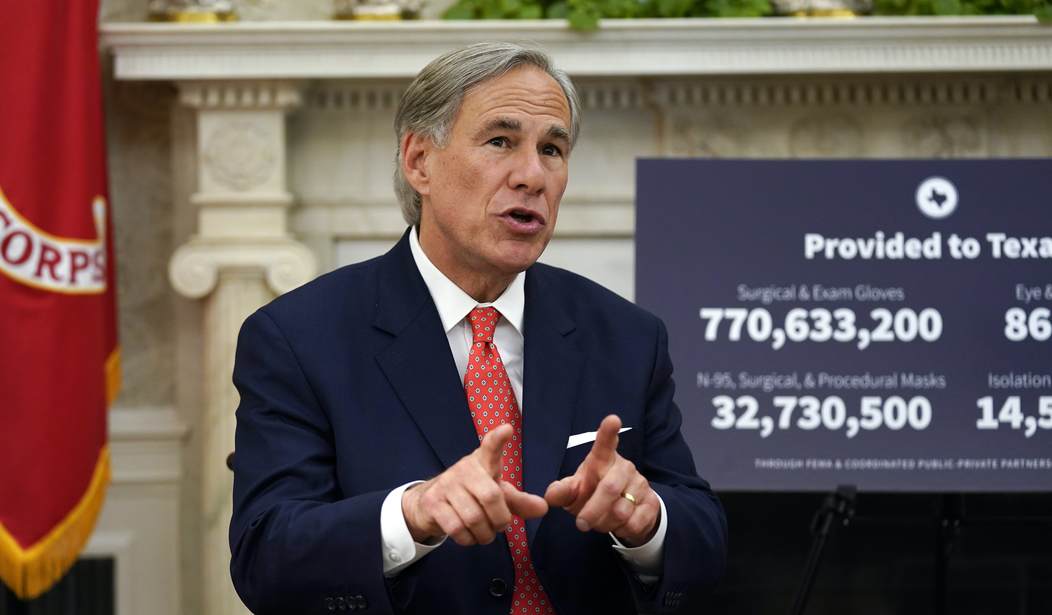When Texas Gov. Greg Abbott lifted his statewide face mask mandate and his limits on business occupancy in early March, Democrats warned that he was inviting a public health disaster. Yet, a month and a half later, newly identified coronavirus cases in Texas have fallen by more than 50 percent, and daily deaths have dropped even more.
Meanwhile, states with stricter COVID-19 regulations have seen spikes in daily new cases. This is not the pattern you would expect to see if government-imposed restrictions played a crucial role in curtailing the pandemic, as advocates of those policies assume.
Abbott's critics did not mince words. President Joe Biden said the governor's decision reflected "Neanderthal thinking." Gilberto Hinojosa, chairman of the Texas Democratic Party, said it was "extraordinarily dangerous" and "will kill Texans."
One reason those dark prophecies have not come true: The practical impact of Abbott's changes was much less significant than his detractors implied.
Most businesses in Texas had been allowed to operate at 75% of capacity since mid-October when Abbott also allowed bars to reopen. It was implausible that removing the cap would have much of an impact on virus transmission, even in businesses that were frequently hitting the 75% limit.
While Abbott said Texans would no longer be legally required to cover their faces in public, he urged them to keep doing so, and many businesses continued to require masks. At the stores I visit in Dallas, there has been no noticeable change in policy or in customer compliance.
Conversely, face mask mandates and occupancy limits did not prevent COVID-19 surges in states such as Michigan, where the seven-day average of newly confirmed infections has risen more than fivefold since March 1; Maine, which has seen a nearly threefold increase; and Minnesota, where that number has more than doubled. Cases also rose during that period, although less dramatically, in other states with relatively strict COVID-19 rules, including Delaware, Maryland, Massachusetts, New Jersey, Pennsylvania and Washington.
Recommended
Florida, a state often criticized as lax, also has seen a significant increase in daily new cases: 34% since mid-March. But Florida, despite its relatively old population, still has a per capita COVID-19 death rate only a bit higher than California's, even though the latter state's restrictions have been much more sweeping and prolonged.
In any event, COVID-19 surges are happening mainly in states with more legal restrictions than Florida or Texas is imposing. The Washington Post nevertheless says experts agree that rising infection numbers are largely due to "a broad loosening of public health measures, such as mask mandates and limits on indoor dining" -- a claim that is tenable only if you ignore all the countervailing examples.
States differ from each other in various ways that may affect the spread of COVID-19, of course, so you can learn only so much from comparisons like these. But several systematic studies have cast doubt on the effectiveness of broad legal restrictions.
While some researchers have concluded that lockdowns had an important impact, others say there is little or no evidence that they affected mortality rates or trends in cases. According to a Nature Human Behaviour study of 226 countries published in November, "a suitable combination of NPIs (nonpharmaceutical interventions) is necessary to curb the spread of the virus," but "less disruptive and costly NPIs can be as effective as more intrusive, drastic ones (for example, a national lockdown)."
In a 2020 National Bureau of Economic Research paper, UCLA economist Andrew Atkeson and two other researchers looked at COVID-19 trends in 23 countries and 25 U.S. states that had seen more than 1,000 deaths from the disease by late July. After finding little evidence that variations in public policy explained the course of the epidemic in different places, they concluded that the role of legal restrictions "is likely overstated."
That much seems safe to say in light of more recent experience in the United States.
Jacob Sullum is a senior editor at Reason magazine. Follow him on Twitter: @JacobSullum.























Join the conversation as a VIP Member